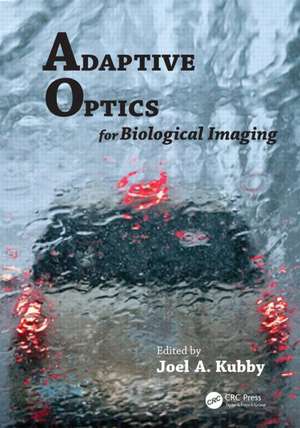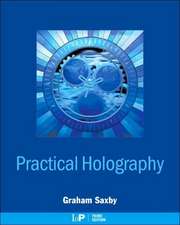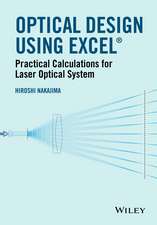Adaptive Optics for Biological Imaging
Editat de Joel A. Kubbyen Limba Engleză Hardback – 26 apr 2013
Organized into three parts, the book covers principles, methods, and applications of adaptive optics for biological imaging, providing the reader with the following benefits:
- Gives a general overview of applied optics, including definitions and vocabulary, to lay a foundation for clearer communication across disciplines
- Explains what kinds of optical aberrations arise in imaging through various biological tissues, and what technology can be used to correct for these aberrations
- Explores research done with a variety of biological samples and imaging instruments, including wide-field, confocal, and two-photon microscopes
- Discusses both indirect wavefront sensing, which uses an iterative approach, and direct wavefront sensing, which uses a parallel approach
| Toate formatele și edițiile | Preț | Express |
|---|---|---|
| Paperback (1) | 317.10 lei 6-8 săpt. | |
| CRC Press – 30 iun 2020 | 317.10 lei 6-8 săpt. | |
| Hardback (1) | 692.64 lei 6-8 săpt. | |
| CRC Press – 26 apr 2013 | 692.64 lei 6-8 săpt. |
Preț: 692.64 lei
Preț vechi: 996.73 lei
-31% Nou
Puncte Express: 1039
Preț estimativ în valută:
132.55€ • 137.88$ • 109.43£
132.55€ • 137.88$ • 109.43£
Carte tipărită la comandă
Livrare economică 14-28 aprilie
Preluare comenzi: 021 569.72.76
Specificații
ISBN-13: 9781439850183
ISBN-10: 1439850186
Pagini: 388
Ilustrații: 242 b/w images, 14 tables and 148
Dimensiuni: 178 x 254 x 36 mm
Greutate: 1.12 kg
Ediția:New.
Editura: CRC Press
Colecția CRC Press
ISBN-10: 1439850186
Pagini: 388
Ilustrații: 242 b/w images, 14 tables and 148
Dimensiuni: 178 x 254 x 36 mm
Greutate: 1.12 kg
Ediția:New.
Editura: CRC Press
Colecția CRC Press
Public țintă
Scientists and engineers in optics, physics, and bioengineering; advanced undergraduate and graduate students in biology and bioengineering; and instrument developers who would like to use adaptive optics in their microscopes.Cuprins
Principles: Principles of Wave Optics. Principles of Geometric Optics. Theory of Image Formation. Methods: Aberrations and Benefit of Their Correction in Confocal Microscopy. Specimen-Induced Geometrical Distortions. Simulation of Aberrations. Overview of Adaptive Optics in Biological Imaging. Wavefront Correctors. Adaptive Optics System Alignment and Assembly. Applications: Indirect Wavefront Sensing: Sensorless Adaptive Optics for Microscopy. Implementation of Adaptive Optics in Nonlinear Microscopy for Biological Samples Using Optimization Algorithms. AO Two-Photon Fluorescence Microscopy Using Stochastic Parallel Descent Algorithm with Zernike Polynomial Basis. Pupil-Segmentation-Based Adaptive Optics for Microscopy. Applications: Direct Wavefront Sensing: Coherence-Gated Wavefront Sensing. Adaptive Optics in Wide-Field Microscopy. Biological Imaging and Adaptive Optics in Microscopy. Adaptive Optical Microscopy Using Direct Wavefront Measurements. Index.
Notă biografică
Joel Kubby is the Department Chair of Electrical Engineering in the Baskin School of Engineering at the University of California at Santa Cruz. His research is in the area of microelectromechanical systems (MEMS) with applications in optics, fluidics, and BioMEMS. Before joining the University of California at Santa Cruz in 2005, he was an area manager with the Wilson Center for Research and Technology and a member of technical staff in the Xerox Research Center Webster in Rochester, New York (1987–2005). Prior to Xerox, he was at the Bell Telephone Laboratories in Murray Hill, New Jersey, working in the area of scanning tunneling microscopy.
Recenzii
"Overall, this is an excellent book, which achieves its stated primary goal. … Without reservations, this is a book I would recommend to anyone who wishes to start learning about the principles and potential of AO in this field."
—Biomedical Engineering OnLine
"The strength of the book is the delicate balance of theory and instrumentation and applications. … Another example of the comprehensive nature of the chapters is a critical discussion of the adaptive optical elements. … Adaptive Optics for Biological Imaging is a good place to start to understand the problem (aberrations induced by the instrument, the objective, and the specimen and its preparation and mounting in the microscope), and the various instrumental and computational approaches to approach a solution (minimize the significant aberrations)."
—Barry R. Masters, Journal of Biomedical Optics, Volume 18, July 2013
"This book is a broad and comprehensive introduction to the use of adaptive optics (AO) in biological microscopy. It provides a much-needed entrée to the field and includes not only the basics and general principles but also discussion of practical implementations and key application areas."
—From the Foreword by Professor Austin Roorda, University of California at Berkeley, and Professor Claire Max, University of California at Santa Cruz
—Biomedical Engineering OnLine
"The strength of the book is the delicate balance of theory and instrumentation and applications. … Another example of the comprehensive nature of the chapters is a critical discussion of the adaptive optical elements. … Adaptive Optics for Biological Imaging is a good place to start to understand the problem (aberrations induced by the instrument, the objective, and the specimen and its preparation and mounting in the microscope), and the various instrumental and computational approaches to approach a solution (minimize the significant aberrations)."
—Barry R. Masters, Journal of Biomedical Optics, Volume 18, July 2013
"This book is a broad and comprehensive introduction to the use of adaptive optics (AO) in biological microscopy. It provides a much-needed entrée to the field and includes not only the basics and general principles but also discussion of practical implementations and key application areas."
—From the Foreword by Professor Austin Roorda, University of California at Berkeley, and Professor Claire Max, University of California at Santa Cruz
Descriere
Written by international leaders in the field, this comprehensive reference presents a complete overview of the core principles, state-of-the-art methods, and emerging applications of adaptive optics in biological imaging. It emphasizes the use of adaptive optics to correct wavefront aberrations caused by light propagation in biological samples. Accessible to readers without a background in optics, the book describes the fundamentals, components, and systems used in adaptive optics. It also covers optics systems as well as newer applications in this rapidly expanding field.
















